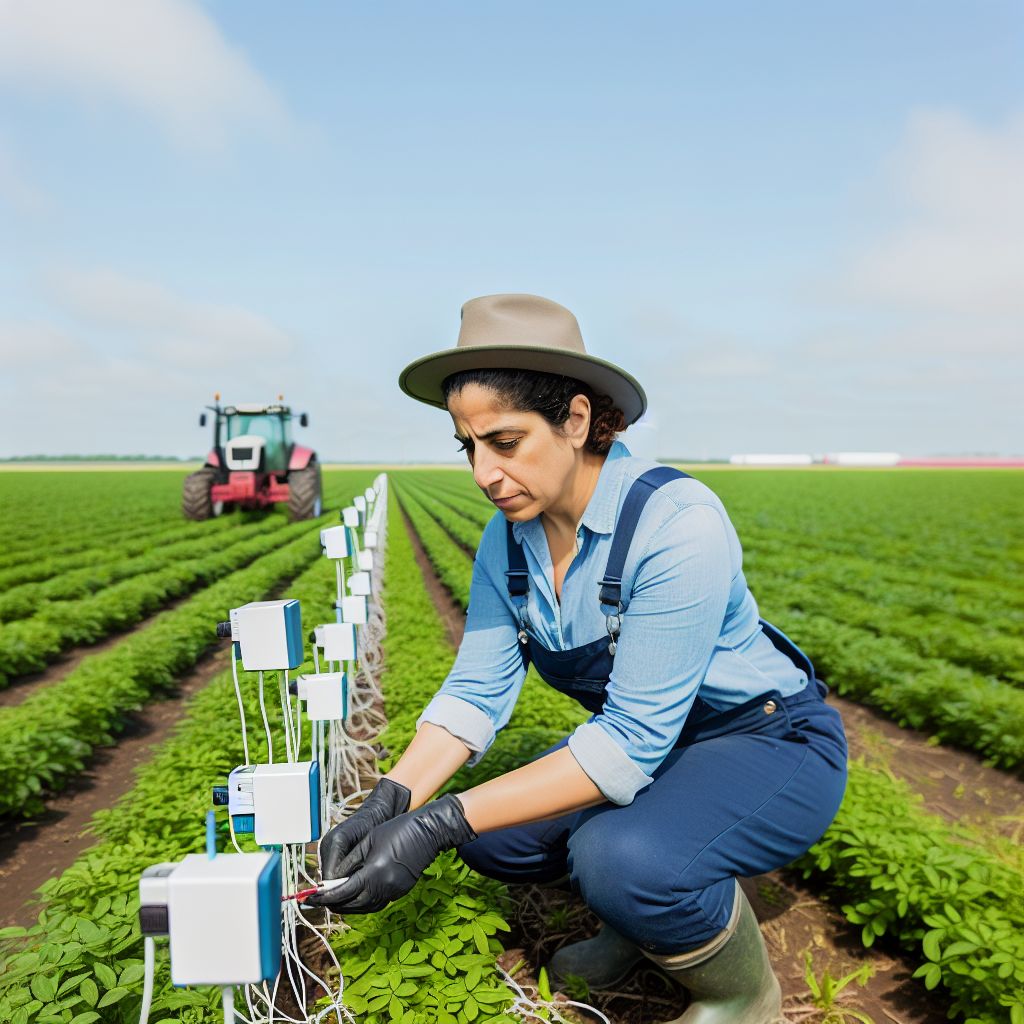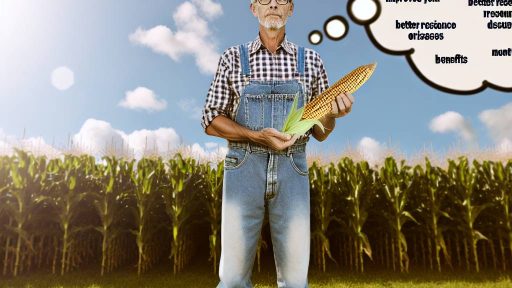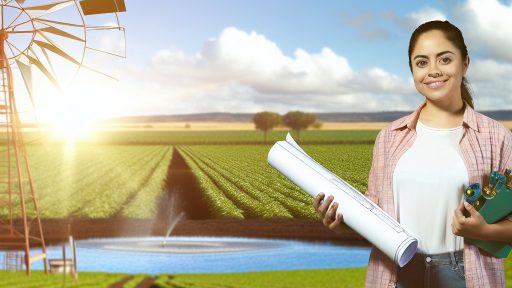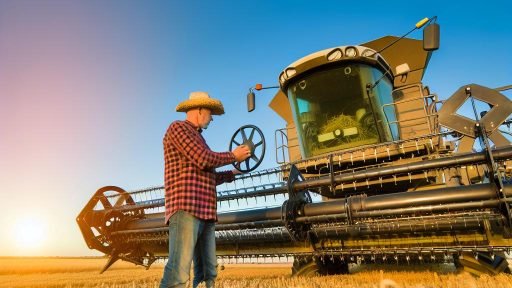Introduction to Smart Sensors in Agriculture
Smart sensors play a crucial role in modern agriculture.
They enhance crop monitoring through real-time data collection.
Farmers can make informed decisions based on accurate information.
The Role of Technology in Farming
Technology has revolutionized various farming practices.
Smart sensors are at the forefront of this innovation.
They monitor soil moisture, temperature, and crop health.
As a result, they help farmers optimize resource use.
Types of Smart Sensors
Different types of smart sensors serve various purposes.
- Soil moisture sensors measure the water content in the soil.
- Temperature sensors monitor the climate conditions for crops.
- Canopy sensors assess plant health and growth rates.
Each type offers unique benefits to crop management.
Benefits of Using Smart Sensors
Implementing smart sensors significantly boosts efficiency.
They enable precise irrigation, conserving water resources.
Additionally, smart sensors improve crop yield and quality.
Ultimately, they lead to more sustainable farming practices.
Challenges in Implementation
Despite their advantages, smart sensors face several challenges.
High initial costs can deter some farmers.
Transform Your Agribusiness
Unlock your farm's potential with expert advice tailored to your needs. Get actionable steps that drive real results.
Get StartedAlso, technical knowledge is required for effective use.
Data integration with existing systems can pose issues.
Benefits of Using Smart Sensors for Crop Monitoring
Enhanced Data Collection
Smart sensors provide real-time data for farmers and agronomists.
This data helps in making informed decisions about crop health.
Moreover, sensors monitor environmental conditions continuously.
As a result, farmers can react promptly to adverse situations.
Improved Resource Management
Smart sensors optimize resource use like water and fertilizers.
They ensure that crops receive the right amount of nutrients.
Consequently, this reduces waste and enhances sustainability.
Farmers witness lower costs and higher yields over time.
Increased Crop Yield
By utilizing accurate data, farmers can maximize crop production.
Smart sensors detect pest infestations early.
This early detection allows for timely interventions.
Thus, crop losses decrease significantly.
Enhanced Soil Monitoring
Soil health is critical for any farming operation.
Smart sensors measure soil moisture and nutrient levels.
This information guides farmers in fertilization practices.
Ultimately, healthy soil leads to better crop yields.
Cost Efficiency
Initial investments in smart sensors pay off over time.
Farmers save money by preventing overuse of resources.
Additionally, improved management practices reduce labor costs.
As a result, profit margins increase for farmers.
Actionable Insights through Analytics
Smart sensors offer data analytics capabilities for farmers.
This enables them to identify trends and patterns in crop growth.
Showcase Your Farming Business
Publish your professional farming services profile on our blog for a one-time fee of $200 and reach a dedicated audience of farmers and agribusiness owners.
Publish Your ProfileConsequently, optimized strategies can be developed for future seasons.
Analytics offer precision agriculture that enhances overall productivity.
Types of Smart Sensors Suitable for Crop Monitoring
Soil Moisture Sensors
Soil moisture sensors gauge the water content in soil.
These sensors help farmers optimize irrigation schedules.
They enable a precise understanding of water needs.
Moreover, they prevent overwatering, conserving resources.
Temperature Sensors
Temperature sensors track the ambient temperature around crops.
They provide vital data for managing crop growth.
Farmers can protect crops from extreme weather conditions.
Additionally, these sensors enhance yield predictions.
Light Sensors
Light sensors measure the amount of sunlight in a field.
These sensors help determine the best planting times.
They support optimal photosynthesis for crops.
Using light sensors, farmers can improve crop quality.
Humidity Sensors
Humidity sensors monitor moisture levels in the air.
They help prevent diseases caused by high humidity.
Farmers can make better decisions on crop protection.
Furthermore, these sensors contribute to overall yield management.
Fertility Sensors
Fertility sensors assess nutrient levels in the soil.
They provide data to optimize fertilizer application.
Farmers can thus enhance soil health and crop performance.
Additionally, these sensors reduce environmental impact.
Pest Sensors
Pest sensors detect the presence of harmful insects.
They alert farmers to potential pest invasions early.
As a result, farmers can take timely action.
This proactive approach minimizes crop damage.
Find Out More: A Comprehensive Guide to Controlled Environment Agriculture
Implementation Process of Smart Sensors on Farms
Identifying the Right Sensors
Farmers start by identifying the specific needs of their crops.
They evaluate the environmental conditions that require monitoring.
Essential factors include soil moisture, temperature, and nutrient levels.
Moreover, farmers consider sensors’ data collection capabilities.
Considering compatibility with existing farm systems is crucial.
Choosing the Appropriate Technology
Next, farmers choose the appropriate technology for their needs.
Options include wireless sensors, IoT devices, and advanced drones.
Each technology varies in cost, range, and data precision.
Farmers should analyze the pros and cons of each option.
Additionally, budget constraints play a significant role in decision-making.
Planning the Installation
After selecting the sensors, farmers plan the installation process.
They define sensor placement for optimal data collection.
This often includes strategic locations within the fields.
Showcase Your Farming Business
Publish your professional farming services profile on our blog for a one-time fee of $200 and reach a dedicated audience of farmers and agribusiness owners.
Publish Your ProfileFarmers also ensure access to power sources for certain devices.
Planning should address how to manage data flow effectively.
Installing the Sensors
Installation begins with marking specific sensor locations.
Farmers install sensors according to the manufacturer’s guidelines.
They also secure connections to power sources and networks.
Additionally, farmers test each sensor to confirm proper functioning.
Regular checks during installation help ensure accuracy.
Data Management and Analysis
Once installed, sensors begin collecting valuable data.
Farmers use software platforms to monitor and analyze this data.
Real-time data helps support informed decision-making.
For example, farmers can adjust irrigation schedules based on moisture levels.
Furthermore, data trends highlight potential crop issues early.
Continuous Monitoring and Adjustments
Continuous monitoring is vital for achieving desired outcomes.
Farmers regularly review sensor data to make necessary adjustments.
They may refine irrigation strategies or fertilizer applications.
Moreover, ongoing evaluations help optimize crop yield and health.
Finally, farmers stay informed about emerging sensor technologies.
Find Out More: Biotechnology In Agriculture Key Applications For Farmers
Data Collection and Management from Smart Sensors
Introduction to Smart Sensors
Smart sensors play a crucial role in modern agriculture.
They collect real-time data on various environmental conditions.
This data helps farmers make informed decisions.
Types of Data Collected
Smart sensors capture a range of data points.
Common data types include soil moisture levels.
They also monitor temperature and humidity.
Additionally, sensors track sunlight exposure and nutrient levels.
Data Integration and Management
Integrating data from different sensors is essential for effective analysis.
Farmers need a centralized management system for this data.
Cloud-based platforms facilitate data storage and accessibility.
These platforms often provide analytical tools for deeper insights.
Benefits of Smart Sensor Data
Utilizing data from smart sensors offers numerous advantages.
Firstly, it enhances crop health monitoring.
Secondly, it aids in precision irrigation practices.
Moreover, it optimizes resource use and minimizes waste.
Future Trends in Data Management
The future of smart sensor technology is promising.
Advancements in AI will enhance data analysis capabilities.
Farmers can expect more automated and precise farming solutions.
Ultimately, these innovations will lead to increased agricultural sustainability.
Gain More Insights: Biotechnological Approaches To Disease Resistant Plants

Integrating Smart Sensors with Existing Farming Technologies
Understanding Smart Sensors
Smart sensors play a significant role in modern agriculture.
They collect real-time data from the fields.
Showcase Your Farming Business
Publish your professional farming services profile on our blog for a one-time fee of $200 and reach a dedicated audience of farmers and agribusiness owners.
Publish Your ProfileFarmers use this information to make informed decisions.
Moreover, these sensors monitor various environmental factors.
Connecting with Existing Equipment
Integrating smart sensors requires compatibility with current farming equipment.
This involves connecting sensors to irrigation systems and tractors.
Farmers can utilize existing data management platforms.
These platforms can process sensor data effectively.
Enhancing Data Collection
Smart sensors improve the accuracy of data collected.
They monitor soil moisture, temperature, and nutrients.
Additionally, they track weather changes in real-time.
As a result, farmers can respond promptly to changing conditions.
Improving Decision-Making Processes
Data from smart sensors supports better farming decisions.
Farmers can analyze trends and patterns in crop performance.
This analysis helps optimize resource allocation.
Consequently, crops yield better results under optimal conditions.
Collaboration with Technology Providers
Successful integration involves collaboration with technology providers.
Providers offer guidance in setting up smart sensors.
They help ensure compatibility with existing systems.
This partnership fosters innovation in farming practices.
Training and Support for Farmers
Training is key to utilizing smart sensors effectively.
Farmers benefit from workshops on sensor management.
Support services can assist with troubleshooting and maintenance.
Ongoing education ensures farmers maximize their technology investments.
Learn More: Cost-Effective Automated Machinery Options For Farmers
Challenges in Implementing Smart Sensors for Crop Monitoring
Technical Complexity
Smart sensors often require sophisticated technology and expertise.
Farmers may struggle to implement complex systems without proper training.
Moreover, integrating sensors with existing farming equipment can prove challenging.
Data Management Issues
Smart sensors generate massive amounts of data.
Farmers must find effective ways to analyze and manage this information.
Data overload can lead to confusion, hindering decision-making processes.
Additionally, ensuring data accuracy is crucial for reliable insights.
Cost Considerations
Implementing smart sensor technology often involves significant initial investment.
Small-scale farmers may find it difficult to afford these systems.
Furthermore, ongoing maintenance and operational costs can add up quickly.
Financial constraints can limit adoption rates among farmers.
Lack of Standardization
The absence of industry standards complicates sensor integration.
This situation can lead to compatibility issues between devices from different manufacturers.
As a result, farmers may face challenges in selecting suitable technology.
Ultimately, this limits the potential benefits of smart sensors.
Resistance to Change
Many farmers may resist adopting new technologies.
This reluctance often stems from traditional farming practices.
Showcase Your Farming Business
Publish your professional farming services profile on our blog for a one-time fee of $200 and reach a dedicated audience of farmers and agribusiness owners.
Publish Your ProfileMoreover, a lack of awareness regarding the benefits of smart sensors can hinder progress.
Education and outreach are essential to overcome these barriers.
Case Studies: Successful Implementation of Smart Sensors in Agriculture
Overview of Smart Sensors
Smart sensors have revolutionized agricultural practices.
They provide real-time data about crop conditions.
This technology helps farmers make informed decisions.
Moreover, it optimizes resource usage on farms.
Case Study: GreenTech Farms
GreenTech Farms employs smart irrigation sensors.
These sensors measure soil moisture levels.
They enable precise watering schedules for crops.
As a result, GreenTech Farms has reduced water usage by 30%.
This innovative approach has increased crop yields significantly.
Case Study: EcoHarvest Solutions
EcoHarvest Solutions uses temperature and humidity sensors.
They monitor the greenhouse environment consistently.
This monitoring helps maintain optimal growth conditions.
Consequently, their tomato plants produced 20% more fruit.
This success illustrates the value of technological integration.
Case Study: AgriTech Innovations
AgriTech Innovations implemented pest detection sensors.
These sensors alert farmers to potential pest infestations.
Farmers can respond quickly to protect their crops.
This proactive approach minimized pesticide use by 40%.
Ultimately, it resulted in healthier produce for consumers.
Lessons Learned from Implementations
Smart sensor integration requires careful planning.
Farmers benefit from training sessions on technology use.
Additionally, collaboration with tech partners enhances success.
Farmers should continually analyze data for optimal results.
Additional Resources
Precision Agriculture: Benefits and Challenges for Technology …
Precision Agriculture for Crop and Livestock Farming—Brief Review …




